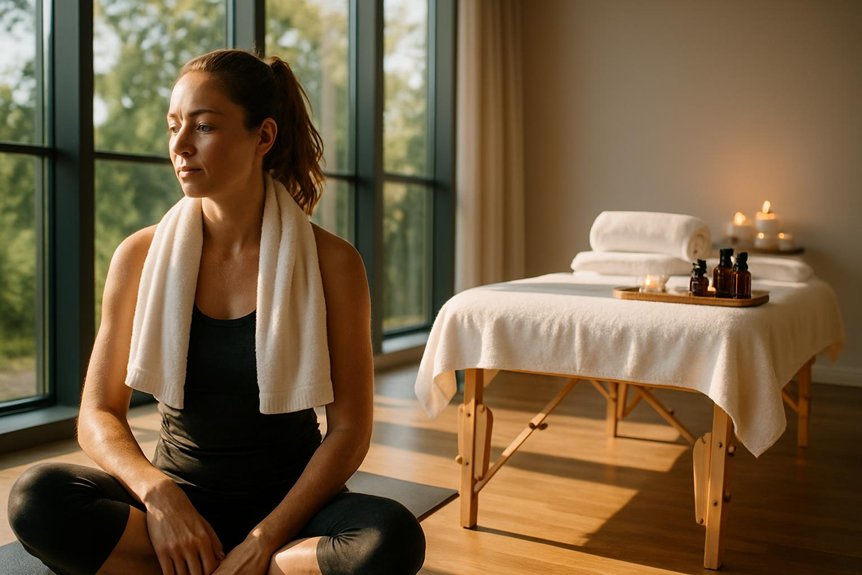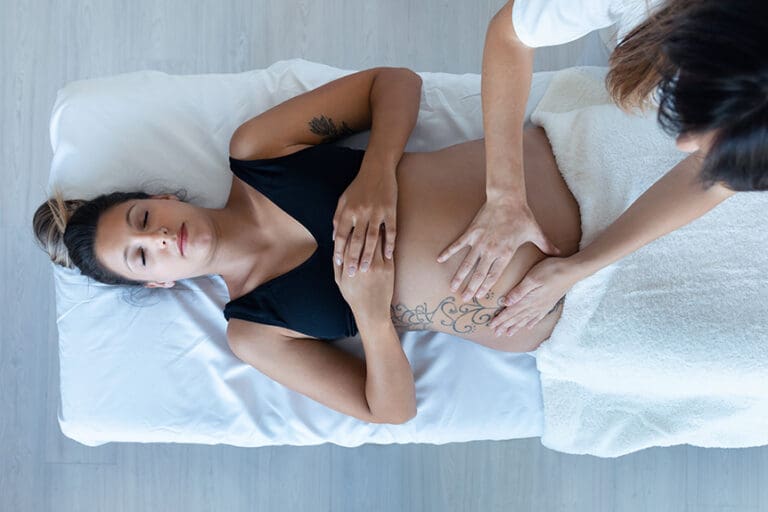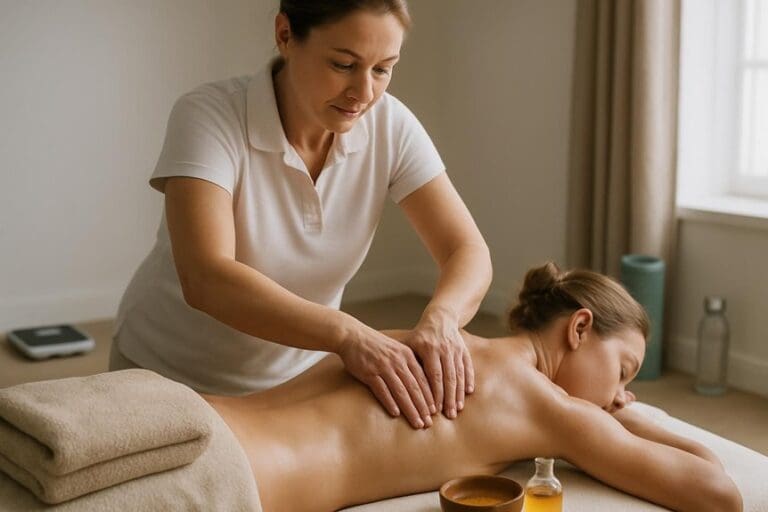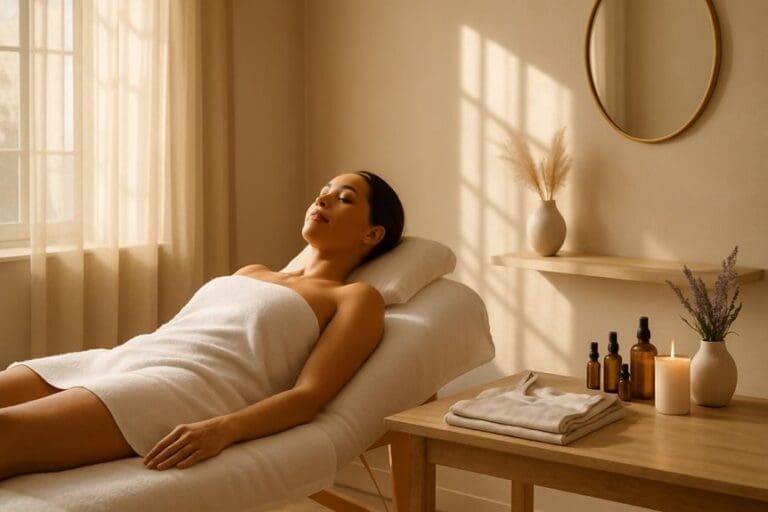Yes—exercise before an essential oil massage is fine when intensity is moderate and the session follows by 1–3 hours. This window lets heart rate, temperature, and skin calm, improving comfort and essential oil benefits. Skip immediately post-strenuous workouts to avoid fatigue and overstimulation. Hydrate, wear breathable layers, and note overuse areas for targeted care. Therapists may use lighter rhythmic strokes and calming or uplifting oils based on activity. If symptoms persist or soreness spikes, reschedule. More timing, oil, and recovery tips follow.
How Exercise Affects Your Body Before an Aromatic Massage Therapy
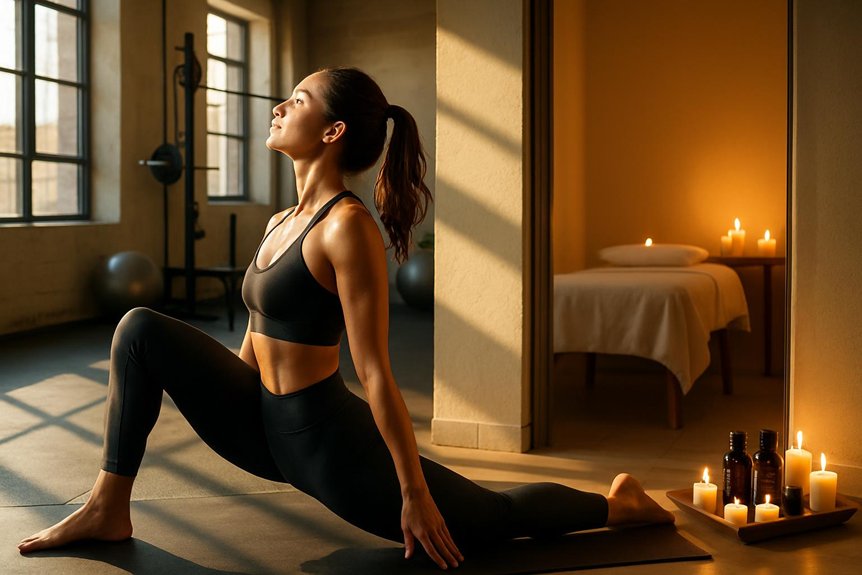
How does recent exercise prime the body for an aromatherapy massage? After physical activity, circulation rises, tissues warm, and muscles become more receptive to touch. Micro-tensions surface, making areas of need easier to identify. Gentle metabolic by-products can accumulate; with skilled strokes and targeted essential oils, these can be supported through natural clearance.
At Spa & Massage, therapists observe that post-exercise warmth allows lighter pressure to feel deeply effective, reducing the need for force and enhancing comfort.
From a client-centered view, breath is already engaged, heart rate eases toward baseline, and the nervous system is poised to shift from effort to restoration. Our therapists select oils—such as lavender for soothing or rosemary for clarity—based on goals, sensitivity, and scent preference, inviting the body to settle while maintaining a pleasant, alert ease.
A similar approach to enhancing well-being through touch can be found in the healing power of reflexology, which also supports circulation and relaxation through specialized techniques.
Ideal Timing Between Your Workout and Massage
While timing can be tailored to individual goals, a practical window between a workout and an essential oil massage is typically 1–3 hours. This pause allows heart rate and body temperature to steady, reduces post-exercise acidity, and primes tissues to receive essential oils without overstimulation.
Hydrating during this interval supports circulation and comfort on the table.
At Spa & Massage, therapists suggest a gentle cool-down, a light snack with electrolytes, and a brief shower before arrival. This preserves the sensual ease many clients seek while keeping muscles receptive to slow, nurturing strokes and focused breathing.
Those training later in the day often prefer a two-hour gap for a calmer nervous system and deeper aromatic effects. Booking within this window helps our team personalise pressure, oil blends, and pacing for your desired outcome.
Light Activity vs. Intense Training: What We Recommend
Although both can pair well with aromatherapy, Spa & Massage advises treating light activity and intense training differently to optimise results.
Gentle movement—such as a relaxed walk, easy cycling, or mobility work—can be followed by aromatherapy the same day, allowing essential oils and slow, nurturing strokes to settle the nervous system and soften mild tension.
For intense training—heavy lifting, sprints, HIIT, or long runs—Spa & Massage recommends leaving a fuller buffer before massage, prioritising calm pressure, slower pacing, and blends that soothe over-stimulated tissues.
In our London clinics, therapists tailor touch and oil selection to the body’s state. After light activity, they may use uplifting citrus or balancing lavender.
Post-intense sessions, many clients receive grounding cedarwood or marjoram with measured, restorative techniques.
Hydration and Nutrition Guidelines Pre-Massage
Before an aromatherapy session, Spa & Massage advises smart hydration: sip water steadily in the hours prior and avoid large volumes immediately before the appointment.
Light, balanced fueling supports comfort and circulation—think a small snack with complex carbohydrates, lean protein, and a little healthy fat 1–2 hours after exercise.
Therapists at our London clinics tailor guidance to each client, especially for those training hard or managing specific health needs.
Smart Pre-Massage Hydration
How much hydration is enough to feel relaxed yet comfortable on the massage table? Spa & Massage recommends a simple, gentle cadence: begin hydrating early, then taper.
After exercise, sip 300–500 ml of water or diluted electrolyte within 30–60 minutes, then take small sips every 20–30 minutes. Stop large intakes 30–45 minutes before the session to avoid a full bladder.
Their therapists suggest pale-straw urine as a practical cue of readiness. For those who sweat heavily or use saunas, a pinch of electrolytes can help maintain fluid balance without bloating.
Cool or room‑temperature water is ideal; avoid carbonated drinks and alcohol. On arrival, clients are offered water and time to settle—an unrushed ritual that supports comfort, circulation, and deeper aromatic ease.
Light, Balanced Fueling
With hydration paced and comfortable, attention turns to light, balanced fueling that supports calm digestion and steady energy on the table. Spa & Massage recommends a modest snack 60–90 minutes pre-session—think a banana with a few nuts, yogurt with berries, or a small oat bar.
After exercise, pairing carbohydrates with a little protein stabilises blood sugar without heaviness.
Clients are advised to avoid large meals, rich or spicy foods, and excess fibre within two hours of essential oil massage, as these can invite bloating when lying prone.
Caffeine and alcohol are best minimised; gentle herbal tea is welcome. Those with sensitive stomachs may prefer rice cakes, toast with honey, or a smoothie.
Our therapists encourage listening to appetite cues—arriving neither hungry nor overly full enhances relaxation and scent receptivity.
Choosing the Right Essential Oils After a Workout
Curiously, the best essential oils after a workout are chosen not by scent alone but by the outcome a client wants—recovery, relaxation, or mental clarity.
At Spa & Massage, therapists guide choices with a gentle, clinical eye: for muscle recovery, they blend rosemary or black pepper with juniper to support circulation and ease heaviness. For relaxation, lavender with Roman chamomile softens the nervous system. For clarity, peppermint or eucalyptus uplifts without overstimulating.
Dilution matters. In our clinics, blends are typically 1.5–3% in a nourishing carrier such as sweet almond or grapeseed, adjusted to skin sensitivity.
Post-exercise skin appreciates hydration, so therapists pair aromatic blends with longer effleurage to calm fascia. Clients are invited to inhale first, then receive targeted application over primary muscle groups.
When to Reschedule: Signs You Should Wait
Even when post-workout massage is planned, certain signs suggest postponing is the safer choice. If heart rate remains elevated long after cooling down, or breathing feels hard to settle, the body may need more time.
Marked muscle soreness beyond usual DOMS, sharp or sudden pain, joint swelling, or restricted range of motion are red flags. So are dehydration, dizziness, headache, nausea, or cramping—especially after heat or endurance sessions.
Skin that is sunburnt, freshly shaved, abraded, or showing rashes should not be exposed to essential oils. Any fever, flu-like symptoms, or recent injury warrants delay.
At Spa & Massage in London, therapists encourage open conversation; they prefer to reschedule rather than risk aggravation, guiding clients toward a time when touch feels restorative, grounded, and deeply welcome.
What to Wear and Bring if You’re Coming From the Gym
After a workout, clothing and essentials can either streamline or complicate an aromatic massage therapy visit. Spa & Massage advises clients to arrive in breathable layers that slip on easily post-treatment—think loose joggers, a soft tee, and supportive trainers or slides. Fresh underwear is essential.
Bringing a small gym towel, deodorant, and a change of socks preserves comfort and clinic hygiene. Hydration helps: a reusable water bottle supports circulation and essential oil absorption. Remove jewelry before arrival.
In our London clinics, therapists provide disposable briefs if desired, and high-quality towels to protect modesty. Oil can lightly transfer, so dark, washable fabrics are wise. Pack hair ties, minimal makeup, and any relevant health notes.
Arrive a few minutes early to cool down; calm skin and steady breath enhance aromatic touch.
How Our Therapists Tailor Techniques for Active Clients
Cooling down in breathable layers sets the stage for targeted care, and from there Spa & Massage therapists tailor essential oil massage to an active body’s needs. They begin with a brief movement and soreness check, then map areas of overuse—calves, hips, shoulders, or forearms—adjusting pressure and pacing accordingly.
In our clinics, lighter rhythmic strokes soothe sympathetic arousal after workouts, while focused myofascial glide and precise trigger-point holds ease localized tension without provoking fatigue.
Oil blends are selected with intention: lavender and sweet marjoram to settle the nervous system; rosemary or black pepper to gently warm fatigued tissues; peppermint to cool hotspots. Joint mobilisations and lengthening holds support range without overstretching.
Breath-led sequencing invites deeper release, and communication remains quiet, attuned, and responsive.
Post-Session Tips to Optimise Recovery and Results
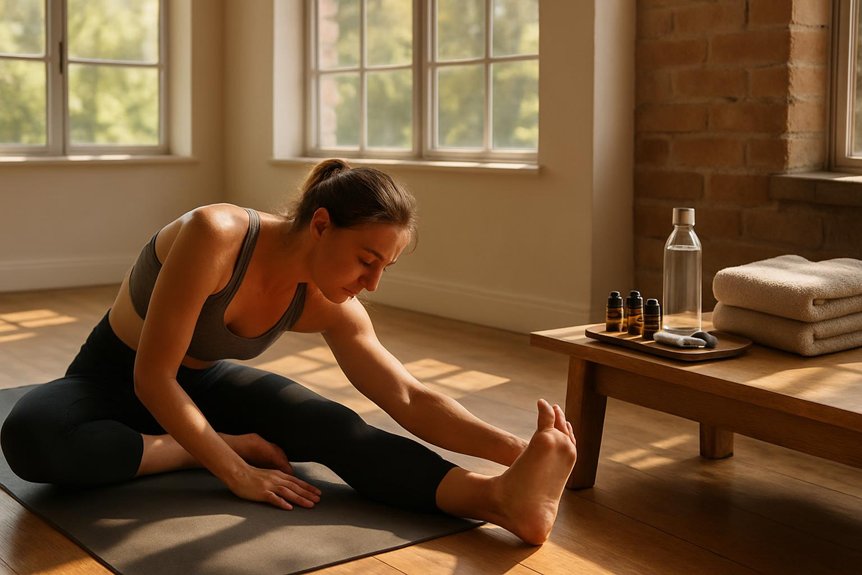
Following a massage therapy, Spa & Massage recommends simple, evidence-based steps to support recovery.
Clients are guided to rehydrate, opt for a light, protein-and-carb snack, and avoid alcohol to aid circulation and tissue repair.
Gentle movement—such as an easy walk or mobility work—is encouraged after a few hours, while more strenuous exercise is best postponed until the next day based on individual response.
Hydration and Nutrition
Why does smart hydration and simple nutrition make such a difference after an essential oil massage? Because improved circulation and parasympathetic activation change fluid balance and energy needs.
At Spa & Massage, therapists recommend sipping water or herbal tea within 30 minutes post-session to support microcirculation, lymphatic flow, and thermoregulation without bloating. A pinch of electrolytes or a mineral-rich option—like coconut water—can help after a workout-plus-massage day.
For nourishment, a light, protein-forward snack with gentle carbohydrates stabilises blood glucose and supports tissue recovery: think Greek yoghurt with berries, hummus with oat cakes, or a small egg-and-leaf salad.
Clients are advised to avoid heavy meals, excess caffeine, and alcohol for several hours, preserving the calming effects of the essential oils used in our clinics and sustaining a soft, grounded energy.
Gentle Movement Timing
A short window of quiet, then deliberate easeful movement, helps lock in the benefits of an aromatic massage. Spa & Massage therapists suggest resting 10–15 minutes after the session to allow circulation, lymph flow, and the aromatic compounds to settle.
When ready, clients can reintroduce gentle motion: slow neck rolls, shoulder circles, ankle pumps, and a mindful walk.
Within two hours, light mobility work—cat–cow, hip openers, and diaphragmatic breathing—maintains suppleness without overwhelming tissues.
Heavier training, running, or intense yoga is best delayed 12–24 hours, especially if the massage addressed deep tension. This timing respects neuromuscular recalibration and reduces post-treatment soreness.
In our clinics, therapists tailor aftercare, inviting clients to notice ease, warmth, and steadier breath as cues to progress movement thoughtfully.
Conclusion
In the end, the body proves delightfully unpersuaded by bravado. Muscles prefer warm-ups to heroics, skin appreciates a rinse, and nervous systems adore punctual hydration. Clients who time workouts sensibly, choose appropriate oils, and arrive neither sprinting nor starving discover that relaxation isn’t a contest. The evidence is clear: plan light activity, pause after intensity, and let circulation settle before the table. With therapists tailoring pressure to real tissues—not gym myths—recovery, sleep, and sanity make a surprisingly triumphant comeback.
